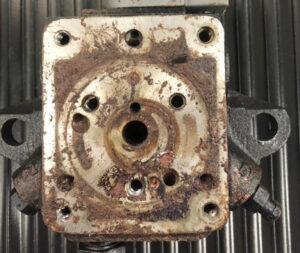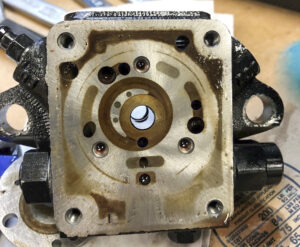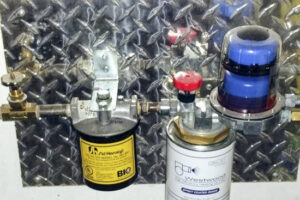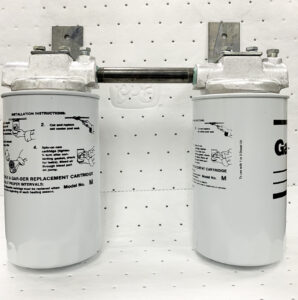For about 10 years, there have been reports of seized fuel units with brown varnish type deposits on the gears and shaft of the fuel unit. Typically, the technician changes the bound fuel unit, and the situation reoccurs—unfortunately, often repeatedly. Fuel units do not normally bind unless contaminated by degraded fuel or other foreign substances. The underlying cause needs to be determined and rectified before changing the fuel unit, otherwise the new fuel unit will also fail, increasing service costs and diminishing customer satisfaction.
Water in the fuel tank is a primary source of these issues. Therefore, good tank housekeeping practices are critical. It is good practice to check for the presence of water in storage tanks at every maintenance visit and is mandatory when confronting a bound fuel unit. Check tanks for water and remove it, then determine the entry point. When it comes to water buildup in the system, areas to be aware of are:
• Missing fill or vent caps
• Rotted fill or vent piping
• Condensation, particularly with outside tanks
• Broken tank gauge vials with outside tanks
• Failing to drain water from new tanks at installation
• Pumping contaminated fuel from an old tank to a new tank
• Tanks must be pitched toward the bottom outlet by ¼” per foot.
• Outside tanks need a manufacturer-approved means to drain water from tank
• Do not use TeflonTM or other similar tape
• Check filter canisters for corrosion and replace them if necessary
• Replace spin-on filter cartridges that have been exposed to water
Manufacturers and NORA (National Oilheat Research Alliance) have conducted extensive testing on fuel samples from affected sites as well as the seized pumps themselves. The failure modes fall into two categories, water-induced corrosion (Figure 1) and sticky polymers (Figure 2). Removing and eliminating the sources of water resolves fuel unit corrosion issues.

Figure 1

Figure 2
Degraded fuel that forms polymers should be approached differently. Biodiesel content is sometimes blamed. Sticky residues occur with no biodiesel content, as well as with biodiesel. There is also no correlation with the delivered fuel itself. Sites that received deliveries on the same day and from the same truck do not show these issues, therefore the issue is site and tank specific. The common factors in most problem sites are two-pipe systems, outside tanks and high particulates in the fuel.
Converting from two-pipe to single pipe, or installing a fuel deaerator (Figure 3), reduces the contact time between fuel and copper. This extends the shelf life of the fuel as well as reducing the fuel flow through the filter extending its life. Using a quality spin-on type filter or, even better, two in a series (Figure 4), provides superior filtration as well as greater depth and capacity to address the particulate issue. In some exploratory work, we have successfully used ultrafine diesel filters (2 micron) for the second filter in the series.

Figure 3

Figure 4
When confronted with a bound fuel unit, keep in mind it is not normal and it is crucial to identify the underlying cause and address it rather than just replacing the fuel unit. The odds are the new one will bind repeatedly if you do not.
Anecdotally, I have heard of as many as 13 pumps being replaced on a single site before the root cause was resolved.
It is a lot easier on everyone and more cost-effective to solve the problem on the first or second call rather than on the fourteenth. ICM
Bob O’Brien is Director of Education of the National Oilheat Research Alliance (NORA)
There’s been a huge amount of buzz lately about the transition to renewable fuels. Unfortunately, not all of it is positive. What is the story? In a nutshell, fossil fuels are going to be phased out by taxation or legislation in the relatively near future. Maybe not on a Federal level but most States in the Northeast U.S. have already enacted legislation, or are in the process of doing so, that will require the elimination of almost all carbon output. This is an ambitious goal but one they are dead serious about.

The good news is that the oil-heat industry—or, as it will become, the liquid fuels industry –has an answer in renewable fuels. Renewable fuels are those produced from renewable resources such as ethanol, renewable diesel and biodiesel. These are versus non-renewable fuels such as coal, propane, natural gas and all other fossil fuels. Biodiesel is the fuel that can replace heating oil and is available in quantities necessary to do so today. There are other biofuels under development and they may become available in the future, but at the moment, biodiesel is the only realistic option. Complaining isn’t going to change things and maintaining the status quo isn’t an option either.
We can forgo the chemistry lesson about the production of biodiesel versus the refining of crude oil into heating oil and start where most technicians start—in the basement. Let’s say you arrive at a new customer’s house for an annual maintenance and they mention the previous company sold B20 and they just had a delivery recently, prior to switching companies.
What is B20, first of all? It’s a mix of 20% biodiesel and 80% heating oil. The number after the B is the percent of biodiesel the blend contains. What might you notice since this unit has been using B20 for a number of years? You won’t notice anything! B20 is so close to No. 2 oil in performance that it’s almost indistinguishable. The fuel will look and smell the same; the flame will appear visually the same. You will need to use instruments to discern any differences at all.
Measuring slight differences
What are the differences? The major difference is the oxygen content of biodiesel versus heating oil, which contains no oxygen. What effect will this have? It will reduce CO2 by about 0.15%, which is not very much variation and even less when you consider that the Air Conditioning, Heating & Refrigeration Institute (AHRI) specification for portable flue gas analyzers allows a tolerance of plus/minus 0.3% for CO2. The CO2 will vary between heating oil and B20 less than the accuracy of the analyzer you use to measure it! You can move the blend level from zero to 20% and anywhere in between seamlessly with no air adjustments needed.
If you’re within 0.3% CO2 of creating smoke, you need a bigger safety margin regardless of the fuel being used. Most field combustion analyzers measure O2 and calculate CO2 and excess air based upon the fuel you set the instrument to. At the B20 level, the difference is so slight that all readings are functionally correct on the heating oil setting.
The other measurable difference is the flame luminosity. A biodiesel flame emits less light than heating oil. This reduced emissivity will affect cad cell resistance readings. A cad cell is a variable resistor that changes resistance inversely to the presence of light—the brighter the light, the lower the resistance. Resistance readings will rise with B20 in comparison to No. 2 oil by about 30–50%; some appliance/burner combinations will be at the lower end of this spectrum and others at the higher end. Typically those with full chambers that heat up quickly will show lower resistance and those with partial or no chamber somewhat higher. All readings with properly adjusted burners using B20 are well below the primary control manufacturer’s lockout threshold and will not cause nuisance service calls.
Flue gas CO2 and cad cell resistance are the only slight differences you can measure in the field and if you aren’t looking closely, you may not notice. There are a few other differences that can be observed if not measured in the field. B20 does have a higher cloud and pour point than heating oil, generally about 7°F degrees higher, although this can vary based upon the properties of both the heating oil and biodiesel used in the blend. For basement and buried tanks, this is a non-issue; outside tanks may present a problem in severe weather.
This can be solved with an additive that reduces the pour point or tank/line heaters, as is done currently with straight No. 2 oil. Using an additive or a combination of additives will allow reliable operation of outside tanks.
Concern has been expressed about biodiesel damaging pump seals, as well as other soft materials (filter gaskets, flex lines, de-aerators, etc.) in fuel systems. Extensive research has been done on this topic over many years. To summarize, this testing shows very good results for B20 compatibility with materials currently used in fuel systems. A full compilation of these studies is available here.

Manufacturers are making changes in their product offerings and increasing the blend level they are rated for. It is prudent to utilize these rated parts and accessories on service and installations to allow a transition to ever-higher blends as the industry moves into a low carbon future. B20 is just the first step on a long road to a carbon neutral liquid fuel future, and just as coal replaced wood and oil
replaced coal, biofuels will replace oil. ICM